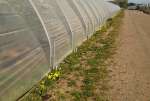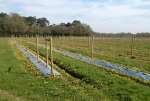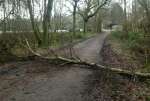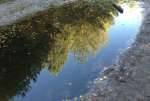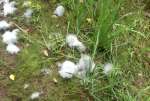Walks in Gorrick Wood
During the 2020 pandemic, with many activities suspended, especially for me tower bell ringing , I kept up my fitness by walking far more. Instead of my usual 1½ mile walk in the area south of the railway I went further south into Gorrick Wood, walking up to 5 miles most days. There are lots of tracks and paths in the wood (some not on the map) and I've walked them all, taking pictures whenever something caught my eye. I hope you enjoy the pictures that I have taken over several hundred walks, in all seasons and in different weather.
Click on any thumbnail to see the full size picture, and use the arrows to move between pictures, or return to the main page.
There and back
To reach the wood from Ludgrove Lane is either a half mile walk along the drive leading to Gorrick Cottage or a ¾ mile walk through Grey's Farm and Heathlands Farm. I normally did a circuit, one way out and the other way back.
The road to Gorrick Cottage runs alongside pasture, parallel to the Guildford railway. The other path starts at a new gate (which had a no cycling sign, now torn off). It follows a narrow path along the boundary of Ludgrove School, which gets very muddy. The northern part was improved by the Council a few years ago and the southern had a very muddy stretch resurfaced with sand & gravel in spring 2021. In May the shady part of the path was adorned with a carpet of down that from a distance looked a bit like frost.
The path then runs alongside the open fields of Grey's Farm and through the poly tunnels of Heathland's farm. Both had an unexpected attraction in May with brilliant displays of rows of dandelions.
Other occasional sights are fallen trees – one on each route in the winter of 2020.
Autumn, dew and mist
Walking in the woods year round I found I took more photos in the autumn and winter than in the summer. The light was more subtle and was often enhanced by mist or dew, helping to create a magical feeling.
Water and ice
In the summer many tracks are dry and sandy, but for much of the autumn and winter many were flooded to varying degrees. On a still day, the large puddles produced some very attractive reflections of the trees and sky.
One track in the middle of the wood had a stretch that never really dried out and for much of the year was completely under water. Look carefully at the picture of it and see the ducks.
When puddles froze over they created attractive patterns and in one puddle the water under the ice drained away leaving it suspended.
The streams in the wood just south of the fruit farms contain a lot of iron, which colours the water bright orange, and after heavy rain causes scum to collect on the surface.
Plants and other things
Among the trees are other plants, with new flowers in spring. There are no flowers in winter but when sunlight catches heavy dew on the bare twigs they look like tiny flowers. There are plenty of fungi, growing in the ground, on roots and on dead trunks. The most unusual I saw was a fibrous mould growing on animal droppings. Alongside one path there's a tree that fell down long ago and then started growing upwards again. I also saw a dead tree stump that seemed to be sprouting stalks, but they were bracken plants growing in the decaying wood.
Keep your eyes open after heavy rain and you can see geophysical processes at work, for example water running down the middle of a path covered in pine needles often pushes them aside to form sinuous banks. One thing I was surprised to see on such a small scale was where water had washed fine sediment (which carries further than the courser grains) into a puddle, something I would only have expected on the edge of a larger body of water or down a hill.
Perhaps the oddest things I saw were the wigwam-like shelters, though they wouldn't provide any shelter at al if it rained. I began seeing them in summer 2020, since when lots have appeared in many different parts of the wood, some rather oddly shaped.
See also, pictures of the area just south of Wokingham , north of Gorrick Wood.
All material and pictures © 2020 - 2021 John Harrison




